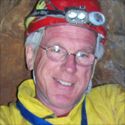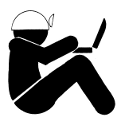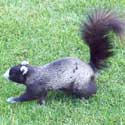Guesstimating L-R-C-F
Moderator: Moderators
56 posts
• Page 1 of 4 • 1, 2, 3, 4
Guesstimating L-R-C-F
One of the things that drives me nuts during surveys is the book person simply guesstimating the left-right-ceiling-floor. Seems it saves time rather than taking a tape and running it from the L-R and Floor side of the survey station in question. Some ceilings can be done with a tape as well... particularly in low duck areas or crawls.
I've brought it up several times to survey leaders and they talk about the time saving and how even a guesstimate is accurate enough. I dunno.
Just wondering how ya'll solve that problem or do you do it too?
It seems to me that it would make the map that much more accurate if it is properly measured with a tape than eyeballing it.
With high ceilings I can see how it would be more simplier to imagine a 6 foot caver and stacking them on top of each other and multiplying the number of 6 foot cavers by six. Or do it the hard way and shine a light and use a protractor and getting the angle and using trigonmetry <sic> to get the height. ...
Just wondeirng here...
I've brought it up several times to survey leaders and they talk about the time saving and how even a guesstimate is accurate enough. I dunno.
Just wondering how ya'll solve that problem or do you do it too?
It seems to me that it would make the map that much more accurate if it is properly measured with a tape than eyeballing it.
With high ceilings I can see how it would be more simplier to imagine a 6 foot caver and stacking them on top of each other and multiplying the number of 6 foot cavers by six. Or do it the hard way and shine a light and use a protractor and getting the angle and using trigonmetry <sic> to get the height. ...
Just wondeirng here...
Without the possibility of death, adventure is not possible. ~ Reinhold Messner
http://ralph.rigidtech.com/albums.php
http://ralph.rigidtech.com/albums.php
-

Ralph E. Powers - NSS Hall Of Fame Poster
- Posts: 2101
- Joined: Sep 10, 2005 5:48 pm
- Location: Chattanooga, TN
- NSS #: 37616
The easiest way is with a laser distance measuring device, like a Disto or Stanley.
When we are surveying, LRUD's (LRCF) are always taken and usually estimated since the passage is small. When it is appropriate we measure with tape or laser. So, for us, it depends on the passage.
When we are surveying, LRUD's (LRCF) are always taken and usually estimated since the passage is small. When it is appropriate we measure with tape or laser. So, for us, it depends on the passage.
Scott McCrea
SWAYGO
SWAYGO
-

Scott McCrea - Global Moderator
- Posts: 3198
- Joined: Sep 5, 2005 3:07 pm
- Location: Asheville, NC USA
- NSS #: 40839RL
- Primary Grotto Affiliation: Flittermouse Grotto
Arms outstretched are about six feet (for me). I use this when we are not taping walls. It is fairly accurate up to about 10-12 feet.
Roppel Caver guy
- Roppelcaver
- Prolific Poster
- Posts: 158
- Joined: Sep 4, 2005 11:23 pm
And who uses the LRUD, aside from those funky looking maps generated by Compass, etc.? Anyone change the sketch to match the LRUD when making the map?
Dwight
Dwight
-

Dwight Livingston - NSS Hall Of Fame Poster
- Posts: 323
- Joined: Sep 6, 2005 7:17 am
- NSS #: 27411
- Primary Grotto Affiliation: Baltimore Grotto
I use LRUD to draw the map -- plans and profiles -- correctly reference the passage to the station location. It is a fundamental tool. And, not to mention how much it helps in refinding survey stations later.
Lots of people use LRUD. I guess the real question is who would not?
Lots of people use LRUD. I guess the real question is who would not?
Roppel Caver guy
- Roppelcaver
- Prolific Poster
- Posts: 158
- Joined: Sep 4, 2005 11:23 pm
Same here. because my sketches are mostly done in proportion, using station distances as a base, it's pretty much a necessity. the sketch on one page could be two feet to a grid or one foot or something else.
Plus, when I do the sketch in cave, marking off LRUD on the sketch first helps define passage width as a starting point. and here's a secret. for long shots, I'll take an extra LRUD in the middle of the shot, especially if hte shot is over 40' and the passage has some character.
john
Plus, when I do the sketch in cave, marking off LRUD on the sketch first helps define passage width as a starting point. and here's a secret. for long shots, I'll take an extra LRUD in the middle of the shot, especially if hte shot is over 40' and the passage has some character.
john
The NSS and WNS: Cooperation, not confrontation.
-

hewhocaves - NSS Hall Of Fame Poster
- Posts: 716
- Joined: Sep 5, 2005 9:43 pm
- Location: Morgantown WV
- Name: John Tudek
- NSS #: 36021
- Primary Grotto Affiliation: MonGrotto
Cavers in pleasant climates have the luxury of applying high sketching standards, unlike cavers in the cold. Also, the smaller the cave passages, the less important it is to accurately measure LRUD.
I have great admiration for talented sketchers, but I'm not one of them.
I have great admiration for talented sketchers, but I'm not one of them.
-

ian mckenzie - NSS Hall Of Fame Poster
- Posts: 549
- Joined: Sep 16, 2005 9:40 am
- Location: Crowsnest Pass, Canada
- Primary Grotto Affiliation: Alberta Speleological Society
ian mckenzie wrote:Cavers in pleasant climates have the luxury of applying high sketching standards, unlike cavers in the cold.
Not true. If you're on an expedition, you are time bound. You're trying to survey as much cave as possible, regardless of temperature.
I'm one of those people that can eyeball it accurately. We actually play games where I guess the distance and then we tape it. But not everyone can do that.
Disto is by far the way to go in my book.
One thing for sure - if you guesstimate incorrectly and have to make a second trip to fix the survey notes, you haven't saved any time.
- Cindy Heazlit
- Frequent Poster
- Posts: 68
- Joined: Sep 9, 2005 2:28 pm
I think we do pretty good surveys these days at Mammoth Cave. For the most part we estimate LRUD, and tape walls in the wider passages. Most passages in Mammoth are of "modest" size (as a percentage of mileage), so estimating works just great. As I said earlier, the outstetched arms gives me within a foot for 15 foot widths or so.
For large passages, the book is the gate on speed anyway, so taping walls keeps otherwise bored surveyors busy.
For large passages, the book is the gate on speed anyway, so taping walls keeps otherwise bored surveyors busy.
Roppel Caver guy
- Roppelcaver
- Prolific Poster
- Posts: 158
- Joined: Sep 4, 2005 11:23 pm
As a sketcher, you're always estimating distances anyway...
Such as the distance to X rock, or the length of a ceiling channel.
I see no problem with also estimating the size of the passage, although I will admit that there is a point where we use some other option, such as trig, a splay shot, or a circumference survey.
Such as the distance to X rock, or the length of a ceiling channel.
I see no problem with also estimating the size of the passage, although I will admit that there is a point where we use some other option, such as trig, a splay shot, or a circumference survey.
-

George Dasher - NSS Hall Of Fame Poster
- Posts: 693
- Joined: Sep 22, 2005 2:00 pm
- Location: West Virginia
- NSS #: 16643
- Primary Grotto Affiliation: Charleston Grotto
Roppelcaver wrote:For large passages, the book is the gate on speed anyway, so taping walls keeps otherwise bored surveyors busy.
agreed. its much harder for the sketcher in narrow passage with ceiling channels, formations, pits, etc... in other words, your average cave passage. the rule of thumb is that the group goes at the speed of the sketcher, but there's a point where the sketcher is just too darn slow.
fortumately, difficult stations for intstruments inevitably crop up, giving the sketcher that extra bit of time (i keep a running tally of total footage for the day in my book) to catch up on what he needs to do. I've gone back a few stations at times to get a cross section or what not in there.
john
-

hewhocaves - NSS Hall Of Fame Poster
- Posts: 716
- Joined: Sep 5, 2005 9:43 pm
- Location: Morgantown WV
- Name: John Tudek
- NSS #: 36021
- Primary Grotto Affiliation: MonGrotto
It depends on the passage...
Sometimes the sketcher is the slowest part of the team...
A lot of times it is someone else...
It doesn't take a long time to sketch a low crawl that is a consistent width. Or a passage that is full of water.
Sometimes the sketcher is the slowest part of the team...
A lot of times it is someone else...
It doesn't take a long time to sketch a low crawl that is a consistent width. Or a passage that is full of water.
-

George Dasher - NSS Hall Of Fame Poster
- Posts: 693
- Joined: Sep 22, 2005 2:00 pm
- Location: West Virginia
- NSS #: 16643
- Primary Grotto Affiliation: Charleston Grotto
Who ever goes to THOSE kinds of caves???????George Dasher wrote:It doesn't take a long time to sketch a low crawl that is a consistent width. Or a passage that is full of water.

Barbara Anne am Ende
"Weird people are my people."
"Weird people are my people."
-

Squirrel Girl - Global Moderator
- Posts: 3198
- Joined: Sep 5, 2005 5:34 am
- Location: Albuquerque, NM
- NSS #: 15789
I think if you can measure it you should. I'll ask point to do that to keep them busy.
Oddly enough, sometimes people can't accurately estimate even the smallest passages, particularly if they're having a day where they're feeling bigger than they really are.
Oddly enough, sometimes people can't accurately estimate even the smallest passages, particularly if they're having a day where they're feeling bigger than they really are.
- John DeLong
- Infrequent Poster
- Posts: 6
- Joined: Sep 6, 2005 9:23 pm
- Location: Glendale WI
Thanks for the replies...
One thing of (minor) interest not that it makes tooo big of a difference is how it would seem the cavers from the east use Left Right UP DOWN whereas I was taught to survey (here in the west) Left Right CEILING FLOOR. I've heard a surveying using the UP DOWN and thought nothing of it but most commonly hear Ceiling Floor. ....
Just find it an interesting demographic ( I think).
One thing of (minor) interest not that it makes tooo big of a difference is how it would seem the cavers from the east use Left Right UP DOWN whereas I was taught to survey (here in the west) Left Right CEILING FLOOR. I've heard a surveying using the UP DOWN and thought nothing of it but most commonly hear Ceiling Floor. ....
Just find it an interesting demographic ( I think).

Without the possibility of death, adventure is not possible. ~ Reinhold Messner
http://ralph.rigidtech.com/albums.php
http://ralph.rigidtech.com/albums.php
-

Ralph E. Powers - NSS Hall Of Fame Poster
- Posts: 2101
- Joined: Sep 10, 2005 5:48 pm
- Location: Chattanooga, TN
- NSS #: 37616
56 posts
• Page 1 of 4 • 1, 2, 3, 4
Return to Survey and Cartography Forum
Who is online
Users browsing this forum: No registered users

